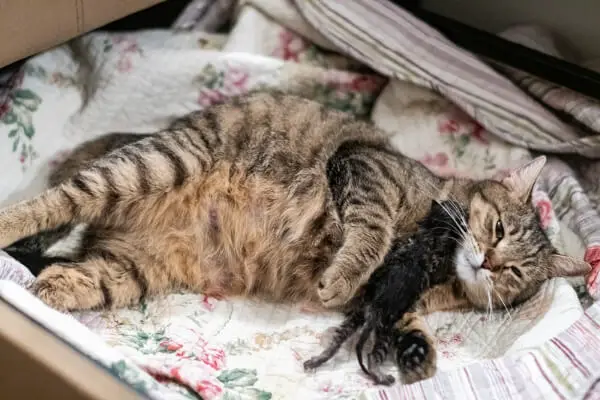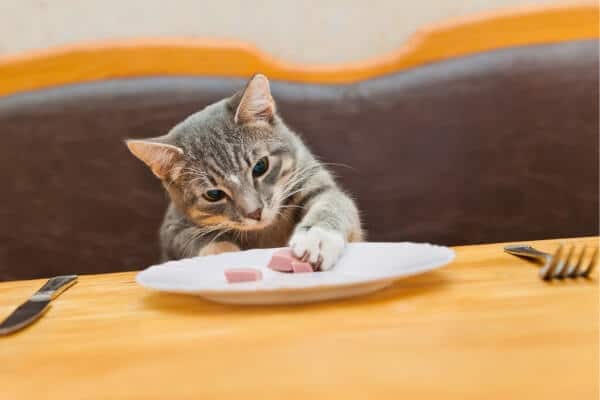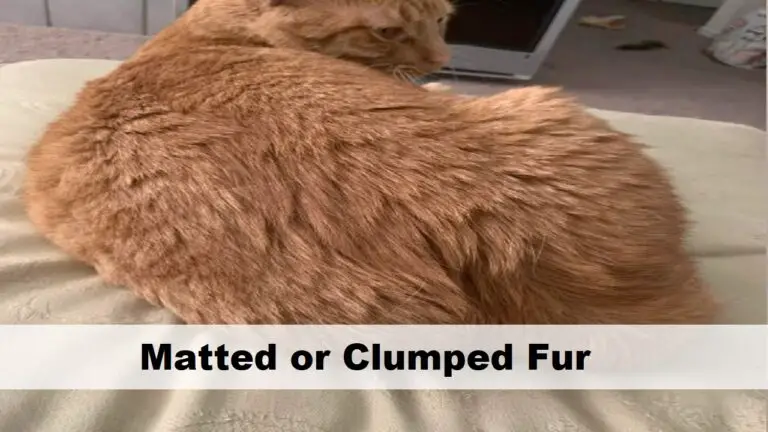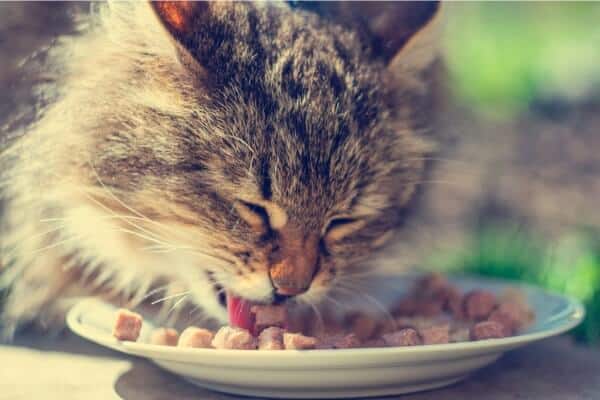Fur Clumps On Cat’s Back (14 Reasons & What To Do)
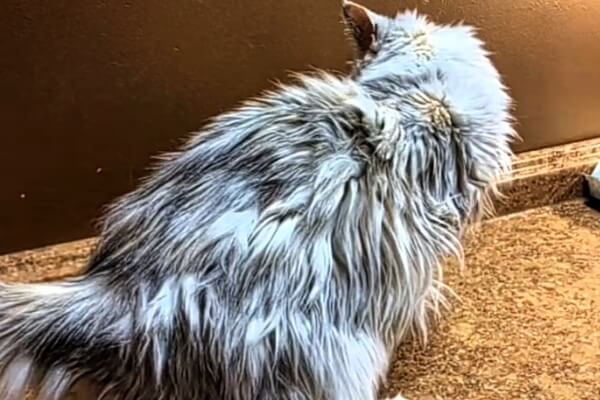
Hair clumps or mats are a common, yet pesky issue that can affect cats of all breeds and ages. These troublesome tangles are formed by interwoven loose hairs, particularly on the cat’s back, and can lead to discomfort.
The fur of your cat’s back can become clumpy due to the shedding of the undercoat, variations in humidity, specific breed characteristics, excess fur, or greasy fur. Other potential causes can range from nutritional deficiencies, obesity, debris in the coat, stress, dental problems impacting grooming habits, skin infections, parasites, allergies, and old age, to various illnesses.
While these clumps may seem daunting, they can be successfully managed and prevented. A simple way to untangle matted fur is by using a slicker brush, a de-shedding tool, and a de-matting tool. For stubborn mats, professional groomers can lend their expertise, ensuring your cat’s comfort and safety.
But as with many things, prevention is better than cure. Regular brushing, adequate nutrition and keeping your cat’s fur dry will ensure a healthier coat less prone to matting. Additionally, routine veterinary visits play a crucial role, as they enable early detection of potential health issues that could contribute to mat formation.
Understanding Cat Fur Clumps
Cat fur clumps, often known as mats, are tangled masses of fur that can occur anywhere on a cat’s body but are most frequently found on the back, particularly in long-haired breeds. They are formed when loose hairs intertwine and become knotted. Over time, these knots can become denser, leading to the formation of larger clumps.
To understand why clumps occur, we must first understand the structure of a cat’s hair. A single hair shaft on a cat consists of three parts: the medulla (the innermost layer), the cortex (the middle layer providing strength and color), and the cuticle (the outer layer). Cats also have different types of hair: guard hairs (the coarse, outer fur), awn hairs (mid-length hairs), and down hairs (the soft, dense undercoat). In cats, unlike in humans, the hairs aren’t round but are flattened and covered with microscopic, shingle-like cells that can interlock, facilitating the formation of mats.
The type of coat your cat has can also impact the likelihood of hair clumping. Cats typically fall into one of three categories: shorthaired, medium-haired, or longhaired. Shorthaired cats have a single layer of dense fur, while medium and longhaired cats have a fluffy undercoat beneath their guard hairs. Longhaired and some medium-haired cats are more prone to hair clumping because their fine undercoat can easily become entangled with the coarser outer hairs. Additionally, certain breeds such as Persians, Maine Coons, or Ragdolls are more prone to developing hair clumps due to their thick, luxurious coats.
Why Does My Cat Have Clumped Or Matted Fur?
1. Undercoat Shedding
Cats have two layers of hair – a top layer (guard hairs) and an undercoat. The undercoat is a softer layer that provides insulation and can be particularly dense in some breeds. The shedding of the undercoat is a natural process that occurs throughout the year, but especially when seasons change. This is a mechanism that allows cats to adjust to different weather conditions. However, when cats shed their undercoat, the loose hairs can become entangled within the top layer, resulting in matting. This issue is particularly significant in breeds that have dense or long undercoats and require frequent grooming to remove loose hairs and prevent matting.
2. Humidity
Environmental conditions can have a significant impact on a cat’s coat. Humidity, in particular, plays a crucial role. High levels of humidity can cause a cat’s fur to absorb moisture, leading it to expansion. These changes in the hair structure can make the hair more likely to become tangled, leading to clumping or matting.
3. Cat Breed
The breed of a cat can significantly affect its likelihood of developing mats. Some breeds, such as Persians, Maine Coons, and Ragdolls, naturally have longer, denser, or more luxurious fur that is more prone to matting. In contrast, short-haired breeds such as Siamese or Bengals, have less fur to become tangled and thus are less likely to develop mats. Additionally, some cats have hair that is naturally more crinkled or wavy, such as Selkirk Rex, which can increase the tendency to form mats.
4. Oily Cat Fur
Some health conditions can lead to changes in a cat’s coat that increase the risk of matting. For instance, hyperthyroidism often causes a range of symptoms, including changes to the coat. The overproduction of thyroid hormones can lead to increased oil production in the skin, making the fur greasy. This oil can cause the fur to stick together, increasing the risk of mats forming. Similarly, Seborrhea is a skin condition that leads to excessive oil production. The greasy skin and hair can easily clump together, leading to matting.
5. Excess Fur
Cats with more fur naturally have a higher chance of developing mats simply due to the volume of hair. This excess fur could be due to the cat’s breed or it could be related to obesity. Overweight or obese cats often struggle with grooming, especially reaching areas like their back or hindquarters, due to limited mobility from their weight. Consequently, these areas are more prone to develop mats from lack of grooming and the accumulation of loose hair. Regular brushing and maintaining a healthy weight are essential in these cases to reduce the chances of matting.
6. Nutritional Deficiency
Just like in humans, a cat’s diet greatly affects its skin and hair health. A deficiency in essential nutrients, like vitamins, minerals, and especially omega-3 fatty acids, can lead to a dry, brittle coat that is prone to breakage and tangling. Feeding your cat a well-balanced diet that meets all its nutritional requirements can help maintain a healthy coat and minimize hair clumping.
7. Obesity
Obesity in cats is a health issue that can indirectly lead to hair clumping. An overweight cat may have difficulty grooming certain parts of its body, such as the back and the hindquarters, due to limited mobility. This lack of grooming in these areas can lead to hair clumping and matting. Regular grooming by the pet owner can assist in preventing mat formation in cats that are unable to groom themselves properly.
8. Outdoor Lifestyle
Cats that spend time outside or in dirty environments can collect various types of debris in their fur, such as dirt, leaves, or even sticky substances. This can become entangled in their coat, leading to knots and eventually mats if not promptly and properly removed. Indoor cats aren’t immune to this issue either, as dust or loose fibers from home textiles can also accumulate in their fur.
9. Dental Problems
Dental issues in cats can indirectly lead to matted fur. If a cat is experiencing oral discomfort due to dental disease, it may avoid grooming itself, leading to potential hair clumping. Regular dental check-ups can help identify and address any dental issues early, maintaining your cat’s overall health, and by extension, their grooming habits.
10. Skin Infections & Parasites
Skin infections and parasites such as fleas, mites, or fungal infections can cause irritation, leading your cat to scratch excessively. This scratching, coupled with the potential skin damage caused by the infection or parasite, can lead to matting. Some parasites can also live in the hair, contributing further to tangle formation. Regular parasite prevention and prompt treatment of any skin infections can help prevent this cause of matting.
11. Allergies
Just like humans, cats can also suffer from allergies, and these can impact the condition of their fur. Allergens can range from certain foods, fleas, and dust mites, to various environmental factors like pollen. Allergic reactions can cause cats to scratch excessively, resulting in broken hairs that are more prone to matting. In addition, allergies can lead to skin inflammation or changes in the skin’s oil production, further increasing the risk of mats.
12. Old Age
As cats age, they might not be as agile or as thorough in their grooming habits. This can be due to a range of issues, from arthritis making it uncomfortable for them to reach certain areas, to cognitive decline reducing their grooming frequency. Furthermore, older cats may have more fragile hair or skin changes that could contribute to matting. Therefore, senior cats often require extra grooming help from their owners to prevent mats from forming.
13. Stress
Stress in cats can result in overgrooming or undergrooming. Both of these behaviors can lead to hair matting. Overgrooming can cause broken hairs that are more prone to clumping while undergrooming allows loose hairs to intertwine and form mats. Common sources of stress for cats can include changes in their environment, the addition of new pets or family members, or illness. Providing a stable, calm environment and attending to any health issues promptly can help mitigate stress-related grooming changes.
14. Illness
Various illnesses can lead to changes in a cat’s coat condition or grooming habits. For instance, conditions like diabetes or kidney disease can cause dehydration, leading to dry, brittle fur that’s more prone to matting. In contrast, conditions that increase oil production, like the aforementioned hyperthyroidism or seborrhea, can lead to oily, clumping fur. Cats suffering from illnesses may also groom less frequently due to lethargy or discomfort. Regular vet check-ups are essential for early disease detection and management, which can help maintain your cat’s coat health and prevent matting.
How To Get Rid Of Matted Cat Furs
1. Try Home Grooming
When dealing with matted cat fur, it’s essential to have the right tools at hand. These include a slicker brush, a de-shedding tool, and a de-matting tool.
Begin the grooming process with a slicker brush. This tool is great for everyday grooming and is effective at catching and removing loose hairs in the top coat. Brush in the direction of the hair growth, making sure to cover all areas. This step helps to prevent the formation of new mats.
Next, use a de-shedding tool which is designed to reach deeper into your cat’s undercoat. It effectively removes loose hairs that the slicker brush may not have reached, reducing the likelihood of these hairs forming clumps. Again, be gentle and mindful of your cat’s comfort.
If you encounter a mat, it’s time to bring out the de-matting tool. Designed to safely break apart mats, start from the outer edges of the mat and work your way in. This can help to minimize any potential discomfort to your cat.
Additionally, you should never use scissors to try to cut out mats as this can risk accidental injuries. If your cat’s fur has too many clumps, or if your cat becomes overly distressed, a professional groomer can effectively remove them by shaving them off with clippers.
You should read our other post on how to remove fur clumps in cat’s back
2. Seek Professional Grooming Services
While regular home grooming can handle most situations, professional groomers have the expertise and tools to handle more severe cases of matting without causing discomfort or injury to your cat. They also know how to groom difficult areas like around the ears or under the legs.
Consider professional services when mats are too close to the skin, too large, or too tight to be safely handled at home. Also, cats that are aggressive or highly anxious about grooming may benefit from professional handling.
3. Dietary Adjustments for Improving Coat Health
Nutrition plays a significant role in the health of your cat’s coat. A diet deficient in essential nutrients can lead to a dry, brittle coat that is more prone to matting. Conversely, a balanced diet can promote a healthy, glossy coat less likely to tangle.
Ensure your cat’s diet includes a good balance of high-quality proteins, fats, and a range of vitamins and minerals. Omega-3 and Omega-6 fatty acids are particularly beneficial for coat health. These are found in fish and flaxseeds, but the easiest way to ensure an adequate intake is to select a high-quality commercial cat food that lists these components.
When to Consult a Veterinarian
While grooming and diet can manage many causes of hair clumping, it’s important to consult a veterinarian if you notice sudden changes in your cat’s coat or grooming habits, if the mats are associated with skin redness, irritation, or wounds, or if your cat seems uncomfortable.
Your vet can diagnose underlying health conditions that might be affecting your cat’s coat, such as allergies, hormonal imbalances, or skin infections. They can also provide advice on managing these conditions and possibly refer you to a professional groomer if severe matting is a symptom.
Additionally, regular vet check-ups are a preventive measure that can catch potential problems early before they impact your cat’s coat health.
Effective Preventive Measures Against Cat Fur Matting
1. Routine Brushing
One of the simplest yet most effective ways to prevent hair clumping is regular brushing. Brushing not only removes loose hairs but also helps distribute the natural oils in your cat’s coat, keeping it healthy and reducing the chances of tangling. The frequency of brushing will depend on your cat’s breed and coat length, but as a general rule, long-haired cats should be brushed daily, while short-haired cats can be brushed a few times a week.
2. Keep The Hair Clean And Dry
Your cat’s environment can significantly impact its coat health. Keep your home clean and free from small objects or debris that could get tangled in your cat’s fur. Ensuring that your cat hair is always dry and maintaining an optimum humidity level can also prevent hair clumps. If the air in your home is too humid, consider using a dehumidifier to help maintain an optimal environment for your cat’s skin and coat.
3. Make Sure Your Cat Is Getting a Balanced Diet
Proper nutrition is essential for a healthy, shiny, and tangle-free coat. Foods rich in omega-3 and omega-6 fatty acids, like fish oil or flaxseed oil, can improve the health of your cat’s skin and fur. Vitamins A and E also promote a healthier coat. Always consult your vet before making dietary changes to ensure the diet meets your cat’s specific needs.
4. Leave It To A Professional Groomer
If grooming your cat at home proves challenging, or if your cat’s fur is prone to serious matting, consider regular appointments with a professional groomer. They have the expertise and tools necessary to properly care for your cat’s coat and prevent matting.
5. Regular Vet Check-ups
Regular veterinary check-ups are vital for preventing hair clumps. A vet can identify underlying health issues, including skin conditions, nutritional deficiencies, and parasitic infestations like fleas, which can contribute to hair clumping. Your vet can also provide preventative treatments and advise on the best practices for maintaining your cat’s coat health.
Why Is My Cat Shedding Clumps Of Fur?
Cat shedding clumps of fur can be a sign of various conditions or circumstances. Here are some potential reasons:
- Seasonal Shedding: Cats naturally shed their fur, especially during the change of seasons. This is a normal process and should not cause any concern unless the shedding is excessive or occurs in clumps.
- Stress: Just like humans, cats can lose hair due to stress. This can be from a change in their environment, such as moving to a new home, the arrival of a new pet or family member, or a change in their daily routine.
- Health Issues: Certain health problems, such as hyperthyroidism, allergies, or skin infections, can cause a cat to shed in clumps. If your cat’s shedding is accompanied by other symptoms like changes in appetite, lethargy, or changes in behavior, consult your vet immediately.
- Poor Nutrition: An improper diet may lead to hair loss in cats. Essential nutrients like protein, fatty acids, and vitamins contribute to a healthy coat. If your cat’s diet lacks these nutrients, it may result in excessive shedding.
- Parasites: Fleas, mites, and other parasites can cause itching and irritation, leading a cat to scratch or lick themselves excessively, which can result in hair loss.
- Age: Older cats may experience changes in their coat and skin, which can result in shedding clumps of fur.
- Grooming Issues: Insufficient grooming can lead to matting and clumping of the fur. When these mats are brushed or fall out, they can take a significant amount of hair with them.
If your cat is shedding clumps of fur, it’s always a good idea to consult with a veterinarian. They can determine whether the shedding is normal or a sign of an underlying health issue that needs to be addressed.
Why Does My Cat’s Fur Keep Getting Matted? (Top 7 Reasons)
FAQs
1. Can I shave my cat to prevent hair clumps?
Shaving your cat can indeed help prevent hair clumps, especially in long-haired breeds. However, it should be done carefully and ideally by a professional groomer to avoid any accidental cuts or injuries. Also, remember that a cat’s coat offers protection from the sun and cold, so consider these factors before deciding to shave your cat.
2. How can I brush a cat that dislikes being brushed?
The key is to make the brushing experience positive. Start by petting your cat and gradually introduce the brush. Brush gently and avoid tugging on knots or mats. Try brushing when your cat is relaxed, perhaps after a meal. You can also use treats as rewards during or after the grooming session. If your cat continues to resist, consider consulting a professional groomer.
3. Why does my cat have dandruff and matted fur?
Dandruff in cats could be due to a variety of reasons including dry skin, lack of grooming, poor diet, or underlying health conditions. Similarly, matted fur can result from lack of grooming, long hair, or conditions causing the cat to neglect grooming. If the dandruff and matting persist, it’s best to consult a vet for possible underlying health issues.
4. My cat’s fur looks separated and spiky. Why is that?
If your cat’s fur looks separated and spiky, it may be due to oil buildup on the skin and fur. This can happen if your cat isn’t grooming itself properly or if it has an underlying skin condition. Less commonly, it can also be a sign of a more serious condition like hyperthyroidism. If you notice a significant change in your cat’s coat, it’s always best to consult with a vet.
Read related posts about


